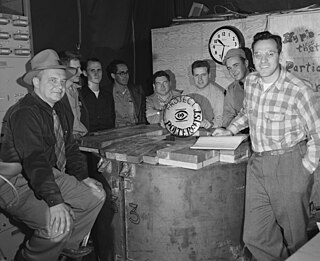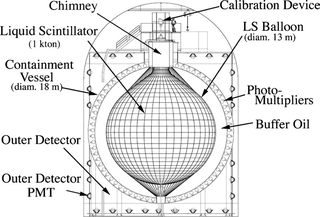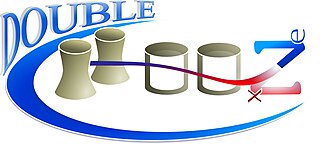
A neutrino is a fermion that interacts only via the weak interaction and gravity. The neutrino is so named because it is electrically neutral and because its rest mass is so small (-ino) that it was long thought to be zero. The rest mass of the neutrino is much smaller than that of the other known elementary particles. The weak force has a very short range, the gravitational interaction is extremely weak due to the very small mass of the neutrino, and neutrinos do not participate in the electromagnetic interaction or the strong interaction. Thus, neutrinos typically pass through normal matter unimpeded and undetected.

Super-Kamiokande is a neutrino observatory located under Mount Ikeno near the city of Hida, Gifu Prefecture, Japan. It is located 1,000 m (3,300 ft) underground in the Mozumi Mine in Hida's Kamioka area. The observatory was designed to detect high-energy neutrinos, to search for proton decay, study solar and atmospheric neutrinos, and keep watch for supernovae in the Milky Way Galaxy.

Neutrino astronomy is the branch of astronomy that observes astronomical objects with neutrino detectors in special observatories. Neutrinos are created as a result of certain types of radioactive decay, nuclear reactions such as those that take place in the Sun or high energy astrophysical phenomena, in nuclear reactors, or when cosmic rays hit atoms in the atmosphere. Neutrinos rarely interact with matter, meaning that it is unlikely for them to scatter along their trajectory, unlike photons. Therefore, neutrinos offer a unique opportunity to observe processes that are inaccessible to optical telescopes, such as reactions in the Sun's core. Neutrinos can also offer a very strong pointing direction compared to charged particle cosmic rays.

The Cowan–Reines neutrino experiment was conducted by physicists Clyde Cowan and Frederick Reines in 1956. The experiment confirmed the existence of neutrinos. Neutrinos, subatomic particles with no electric charge and very small mass, had been conjectured to be an essential particle in beta decay processes in the 1930s. With neither mass nor charge, such particles appeared to be impossible to detect. The experiment exploited a huge flux of electron antineutrinos emanating from a nearby nuclear reactor and a detector consisting of large tanks of water. Neutrino interactions with the protons of the water were observed, verifying the existence and basic properties of this particle for the first time.

A solar neutrino is a neutrino originating from nuclear fusion in the Sun's core, and is the most common type of neutrino passing through any source observed on Earth at any particular moment. Neutrinos are elementary particles with extremely small rest mass and a neutral electric charge. They only interact with matter via the weak interaction and gravity, making their detection very difficult. This has led to the now-resolved solar neutrino problem. Much is now known about solar neutrinos, but the research in this field is ongoing.

The Kamioka Liquid Scintillator Antineutrino Detector (KamLAND) is an electron antineutrino detector at the Kamioka Observatory, an underground neutrino detection facility in Hida, Gifu, Japan. The device is situated in a drift mine shaft in the old KamiokaNDE cavity in the Japanese Alps. The site is surrounded by 53 Japanese commercial nuclear reactors. Nuclear reactors produce electron antineutrinos () during the decay of radioactive fission products in the nuclear fuel. Like the intensity of light from a light bulb or a distant star, the isotropically-emitted flux decreases at 1/R2 per increasing distance R from the reactor. The device is sensitive up to an estimated 25% of antineutrinos from nuclear reactors that exceed the threshold energy of 1.8 megaelectronvolts (MeV) and thus produces a signal in the detector.
The cosmic neutrino background is the universe's background particle radiation composed of neutrinos. They are sometimes known as relic neutrinos.
The Mikheyev–Smirnov–Wolfenstein effect is a particle physics process which modifies neutrino oscillations in matter of varying density. The MSW effect is broadly analogous to the differential retardation of sound waves in density-variable media, however it also involves the propagation dynamics of three separate quantum fields which experience distortion.

A neutrino detector is a physics apparatus which is designed to study neutrinos. Because neutrinos only weakly interact with other particles of matter, neutrino detectors must be very large to detect a significant number of neutrinos. Neutrino detectors are often built underground, to isolate the detector from cosmic rays and other background radiation. The field of neutrino astronomy is still very much in its infancy – the only confirmed extraterrestrial sources as of 2018 are the Sun and the supernova 1987A in the nearby Large Magellanic Cloud. Another likely source is the blazar TXS 0506+056 about 3.7 billion light years away. Neutrino observatories will "give astronomers fresh eyes with which to study the universe".

The Homestake experiment was an experiment headed by astrophysicists Raymond Davis, Jr. and John N. Bahcall in the late 1960s. Its purpose was to collect and count neutrinos emitted by nuclear fusion taking place in the Sun. Bahcall performed the theoretical calculations and Davis designed the experiment. After Bahcall calculated the rate at which the detector should capture neutrinos, Davis's experiment turned up only one third of this figure. The experiment was the first to successfully detect and count solar neutrinos, and the discrepancy in results created the solar neutrino problem. The experiment operated continuously from 1970 until 1994. The University of Pennsylvania took it over in 1984. The discrepancy between the predicted and measured rates of neutrino detection was later found to be due to neutrino "flavour" oscillations.
Inverse beta decay, commonly abbreviated to IBD, is a nuclear reaction involving an electron antineutrino scattering off a proton, creating a positron and a neutron. This process is commonly used in the detection of electron antineutrinos in neutrino detectors, such as the first detection of antineutrinos in the Cowan–
T2K is a particle physics experiment studying the oscillations of the accelerator neutrinos. The experiment is conducted in Japan by the international cooperation of about 500 physicists and engineers with over 60 research institutions from several countries from Europe, Asia and North America and it is a recognized CERN experiment (RE13). T2K collected data within its first phase of operation from 2010 till 2021. The second phase of data taking (T2K-II) is expected to start in 2023 and last until commencement of the successor of T2K – the Hyper-Kamiokande experiment in 2027.

Hyper-Kamiokande is a neutrino observatory and experiment under construction, conducted in Japan by the collaboration of institutes from 21 countries from six continents. As a successor of the Super-Kamiokande (SK) and T2K experiments, it is designed to search for proton decay and detect neutrinos from natural sources such as the Earth, the atmosphere, the Sun and the cosmos, as well as to study neutrino oscillations of the man-made accelerator neutrino beam. The beginning of data-taking is planned for 2027.

Borexino is a deep underground particle physics experiment to study low energy (sub-MeV) solar neutrinos. The detector is the world's most radio-pure liquid scintillator calorimeter and is protected by 3,800 meters of water-equivalent depth. The scintillator is pseudocumene and PPO which is held in place by a thin nylon sphere. It is placed within a stainless steel sphere which holds the photomultiplier tubes (PMTs) used as signal detectors and is shielded by a water tank to protect it against external radiation. Outward pointing PMT's look for any outward facing light flashes to tag incoming cosmic muons that manage to penetrate the overburden of the mountain above. Neutrino energy can be determined through the number of photoelectrons measured in the PMT's. While the position can be determined by extrapolating the difference in arrival times of photons at PMT's throughout the chamber.
Lorentz-violating neutrino oscillation refers to the quantum phenomenon of neutrino oscillations described in a framework that allows the breakdown of Lorentz invariance. Today, neutrino oscillation or change of one type of neutrino into another is an experimentally verified fact; however, the details of the underlying theory responsible for these processes remain an open issue and an active field of study. The conventional model of neutrino oscillations assumes that neutrinos are massive, which provides a successful description of a wide variety of experiments; however, there are a few oscillation signals that cannot be accommodated within this model, which motivates the study of other descriptions. In a theory with Lorentz violation, neutrinos can oscillate with and without masses and many other novel effects described below appear. The generalization of the theory by incorporating Lorentz violation has shown to provide alternative scenarios to explain all the established experimental data through the construction of global models.
The K2K experiment was a neutrino experiment that ran from June 1999 to November 2004. It used muon neutrinos from a well-controlled and well-understood beam to verify the oscillations previously observed by Super-Kamiokande using atmospheric neutrinos. This was the first positive measurement of neutrino oscillations in which both the source and detector were fully under experimenters' control. Previous experiments relied on neutrinos from the Sun or from cosmic sources. The experiment found oscillation parameters which were consistent with those measured by Super-Kamiokande.

Double Chooz was a short-baseline neutrino oscillation experiment in Chooz, France. Its goal was to measure or set a limit on the θ13 mixing angle, a neutrino oscillation parameter responsible for changing electron neutrinos into other neutrinos. The experiment uses reactors of the Chooz Nuclear Power Plant as a neutrino source and measures the flux of neutrinos they receive. To accomplish this, Double Chooz has a set of two detectors situated 400 meters and 1050 meters from the reactors. Double Chooz was a successor to the Chooz experiment; one of its detectors occupies the same site as its predecessor. Until January 2015 all data has been collected using only the far detector. The near detector was completed in September 2014, after construction delays, and started taking data at the beginning of 2015. Both detectors stopped taking data in late December 2017.
A geoneutrino is a neutrino or antineutrino emitted in decay of radionuclide naturally occurring in the Earth. Neutrinos, the lightest of the known subatomic particles, lack measurable electromagnetic properties and interact only via the weak nuclear force when ignoring gravity. Matter is virtually transparent to neutrinos and consequently they travel, unimpeded, at near light speed through the Earth from their point of emission. Collectively, geoneutrinos carry integrated information about the abundances of their radioactive sources inside the Earth. A major objective of the emerging field of neutrino geophysics involves extracting geologically useful information from geoneutrino measurements. Analysts from the Borexino collaboration have been able to get to 53 events of neutrinos originating from the interior of the Earth.
The Enhanced NeUtrino BEams from kaon Tagging or ENUBET is an ERC funded project that aims at producing an artificial neutrino beam in which the flavor, flux and energy of the produced neutrinos are known with unprecedented precision.
Supernova neutrinos are weakly interactive elementary particles produced during a core-collapse supernova explosion. A massive star collapses at the end of its life, emitting on the order of 1058 neutrinos and antineutrinos in all lepton flavors. The luminosity of different neutrino and antineutrino species are roughly the same. They carry away about 99% of the gravitational energy of the dying star as a burst lasting tens of seconds. The typical supernova neutrino energies are 10 to 20 MeV. Supernovae are considered the strongest and most frequent source of cosmic neutrinos in the MeV energy range.






















